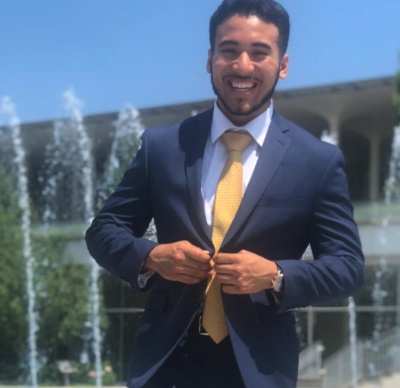Smithsonian Astrophysical Observatory partners with National Society of Black Physicists to launch annual research internship and recruitment opportunity
Cambridge, MA (September 16, 2020)— The Smithsonian Astrophysical Observatory (SAO) and the National Society of Black Physicists (NSBP) today announced the formation of the NSBP/SAO Event Horizon Telescope (EHT) Scholars Program, creating opportunities for early career physicists from underrepresented backgrounds to engage in cutting-edge black hole research.
The EHT Scholars Program aims to ensure that students from all backgrounds have access to opportunities in advanced astrophysical research internships and mentorship, and was proposed by Richard Anantua—postdoctoral researcher at SAO and Black Hole Initiative (BHI) Fellow—to support positive change in the EHT collaboration. “The goal of the EHT Scholars Program is to create permeability between spaces in research that have traditionally been siloed, to foster new connections, and to enhance the diversity of the academic landscape,” said Anantua. “We’re giving training to students who might not normally come to EHT, and in return the students give to the missions by bringing their viewpoints to the projects they are working on.” Shep Doeleman, Founding Director of the EHT added, “EHT provides an opportunity for young physicists early in their careers to be involved in a high-profile project, and the Scholars Program is our way to make that happen more equitably.”
For Anantua, working with NSBP to build and launch the internship program made perfect sense. “NSBP’s mission and EHT’s vision are symbiotic. We are both searching for new ideas, new outlets, new opportunities for growth, and we will both benefit from the expansion of diversity at EHT.” Stephon Alexander, physics professor at Brown University and President, NSBP, added, “One of the main goals of NSBP is to support the success of Black physicists. This partnership will provide NSBP members at all levels opportunities to engage with collaborators at SAO and emerge as leading researchers.”
For the SAO-EHT group, this is the first time that researchers have actively sought undergraduate interns, previously relying on the EHT’s reputation to entice students to get in touch on their own. “In the past we didn’t recruit undergraduates. We were hearing from people who were self-selecting, and who already had immense support and encouragement. That’s not representative,” said Doeleman. “We’re working now to be more proactive. This program isn’t the only way to do that, but it is a great way to start.”
For his part, Anantua believes that this is only the beginning. “The EHT Scholars Program started at SAO because many EHT leaders are here, and because we’re leading the next generation of EHT projects, but this could be a template for a global internship program to get underrepresented minorities all over the world more involved. The program has great potential to be scalable; this is a blueprint for permanent change.”
The 2020 EHT Scholars Program welcomed inaugural interns Elon Price, Fisk-Vanderbilt graduate student and member of NSBP, and Paul Tola, SUNY New Paltz undergraduate student and member of Prep for Prep and the National Society for Hispanic Physicists (NSHP).
For Price, the program offered an invaluable look into the opportunities available within the field of astrophysics. “I got exposure to astrophysics and general relativity in a way I never considered,” said Price. “I’m now very interested in this type of work.” Price’s research focuses on modeling, and simulating the accreted plasma observed by the EHT in order to help design advanced EHT array configurations. Price is advised by SAO astronomers Anantua and Christian Fromm.
The program offered an opportunity for Tola to further develop skills that could help him to launch a career in myriad areas of science and technology. “This experience has helped me develop a problem-solving and solutions-based mindset, to shift my perspective and methods to continue to make progress and has taught me how to decipher between lots of data to figure out specifically what is important,” said Tola. “These abilities are crucial for a number of fields and are something I will take with me to my next endeavors.” Tola’s research focuses on the development of simulations of very long baseline interferometry (VLBI) to assess requirements for sensitivity at ngEHT telescope stations, and to investigate the effects of atmosphere, telescope mechanics, and other perturbations on the quality of simulated observations. Tola is advised by EHT instrumentation team member Alexander Raymond.
The EHT Scholars program launched in July 2020 with support from the Smithsonian Institution and the National Science Foundation. An open call for applications for the 2021 program will launch in Winter 2020/2021.
About Center for Astrophysics | Harvard & Smithsonian
Headquartered in Cambridge, MA, the Center for Astrophysics (CfA) | Harvard & Smithsonian is a collaboration between the Smithsonian Astrophysical Observatory and the Harvard College Observatory. CfA scientists study the origin, evolution and ultimate fate of the universe.
Media Contact:
Center for Astrophysics | Harvard & Smithsonian
Fred Lawrence Whipple Observatory
Amy Oliver, Public Affairs
520-879-4406


